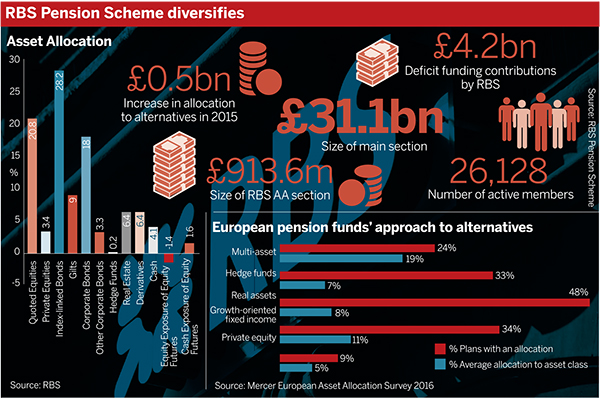The RBS Pension Scheme has made a number of new investments as part of its long-term plan to diversify its portfolio.
Many other schemes have diversified in recent months, including the Vodafone’s £4.9bn defined benefit schemes.
The RBS scheme has had a diversification plan in place for the past six years. During the second half of 2015, the £31.1bn scheme added new mandates as part of this strategy.
We have seen an increase in the level of diversification in general
Simeon Willis, KPMG
“The fund continued to expand into a range of new asset classes to pick up a broader set of return streams,” states the scheme’s latest report for the nine months ending December 31 2015.
One of the new additions included a new customised momentum strategy, “which invests across equities, rates, commodities and currency and seeks to weight exposures to outperform in down markets”, explains the report.
Insurance-linked securities
The scheme, which has received £4.2bn of deficit funding contributions from the sponsor, also now has “a portfolio of US life settlements as part of the broader insurance portfolio”, according to the report.
While the exact amount was not disclosed, the scheme has an exposure of around £575m to insurance, including life settlements, litigation finance and non-life risks.
Life settlements are a form of insurance-linked security, said Simeon Willis, director and head of investment strategy at KPMG.
“In general, schemes have allocated more to insurance-linked securities than they have done previously, so it’s been an area of growing interest for investors, but it’s still a fairly niche area,” he said, adding that it will probably remain a niche area due to the size of the market.
How small schemes gain ILS exposure
While larger schemes are able to allocate to a more diverse range of asset classes, Willis noted that smaller schemes can gain a lesser exposure to similar sorts of investments, including insurance-linked securities, through diversified growth funds, for example.
“I think the proliferation of diversified growth funds has helped more schemes get access to good diversification,” he said. “We have seen an increase in the level of diversification in general, although some of the big schemes have been doing this for a long time.”
However, he said it is important to remember that “diversifying in itself isn’t enough to manage your overall risk levels”.
Rather than relying solely on diversification to manage interest rate and inflation risk, schemes “need to specifically address those risks in addition to having a diversified portfolio” because “diversification alone isn’t sufficient”, he said.
Illiquid alternatives
According to Willis, smaller schemes turn to DGFs when looking to create a more diverse portfolio. But there are asset classes that can give both diversification and returns.
“Private market debt would be a great example of where schemes are looking to diversify and still maintain returns in the current environment, because there’s a genuine liquidity premium that can be accessed,” said Willis.
RBS banks on preferred provider for drawdown
RBS’s defined contribution scheme is exploring the addition of a drawdown option via an external provider to enable a seamless transition into retirement for its members.
Simon Cohen, chief investment officer at Dalriada Trustees, said: “More and more schemes are thinking about diversification [and] thinking about managing the risks in their pension plan.”
Cohen also highlighted the fact that private market debt and infrastructure are currently popular asset classes for pension funds looking to diversify.
Vodafone scheme diversifies with alternatives additions
Vodafone has made a foray into a number of new asset classes, including alternative beta, alternative credit and private market investments, for greater diversification.
However, from a trustee perspective, he said he is keen to see more diversified illiquid alternative funds that could be used by smaller pension schemes because DGFs typically have daily liquidity and therefore can not invest too much in illiquid asset classes.
“It would be good to see a pooled fund structure that invests in infrastructure, private markets [and] direct lending,” he said.














